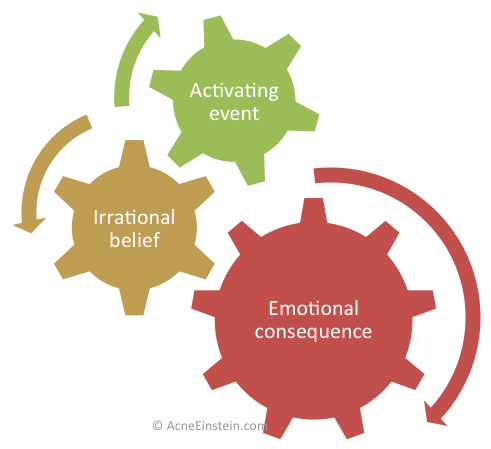
Source: medium.com
Rational Emotive Behavior Therapy (REBT) was first presented in 1955 by Albert Ellis, and it caused a tremendous alteration from the common types of therapies during that period. It then catalyzed several sub-therapies, which were typically referred to as cognitive behavioral therapy or CBT. Cognitive behavioral therapy and Rational Emotive Behavior Therapy complement in different ways. Primarily, both REBT and CBT’s man concept entails human behaviors and emotions that are mostly produced by thoughts, opinions, beliefs, and viewpoints – not by occurrences themselves. Hence, modifying one’s thoughts results in behavioral and emotional changes.
However, in this article, we will be focusing on the main distinctions or disparities between the two therapies.
- REBT involves showcasing excellent solutions to problems regarding self-confidence. This is called the USA or Unconditional Self-Acceptance. It demonstrates absolute self-acceptance instead of some kind of self-assessment. Most therapists handling CBT emphasize reinforcing their patients’ self-confidence by boosting their good qualities. This approach has a lot of drawbacks, which include having decreased self-confidence when you behave negatively. The patient then becomes afraid of taking risks, struggles with proving his point, or is narrowly satisfied with himself.
- Unconditional Self-Acceptance and evading the self-assessment setup avoids a multitude of difficulties with self-assessment or self-rating. USA entails the absolute acceptance of oneself as the flawed person that you are regardless of your performance or if other people love you or not. If you lose your job, for instance, score your employment performance as insignificant but certainly not oversimplify to say that you are a useless person. You are capable of assessing your negative qualities and emphasizing ways to do better next time.
- REBT tackles the moral foundations of emotional disruption and misleading thoughts, which is the main focus of cognitive behavioral therapy, making REBT more prevailing. When a person displaces his autocratic requests, his distorted thoughts are amended.

Source: acneeinstein.com
Let’s assume that you have plans to ask a friend to go on a date and you feel really nervous about it. You begin to think, “She didn’t notice me yesterday even if I was right in front of her. She’s probably going to refuse me.” Because there are various rationalizations for your friend’s actions, most of which you do not know if you just look at her behavior, cognitive behavioral therapy refers to this statement as simply ‘reading the mind,’ subsequently negating it as a biased thought. Rather, REBT sees the primary reason that you hastily came up with this decision, like telling yourself that you definitely require your friend’s acceptance. If she refuses you, it would be really terrible and ‘It would only show how much of a loser I am and that I’m a failure with women.”
Consequently, yielding your demand for recognition wouldn’t only enhance your worries of being refused or denied in the future but also in essentially all social relations. Utilizing CBT to prevent mind-reading most probably becomes more restricted. REBT suggests three primary demands driving one’s disrupted thoughts and fundamental emotional disruption:
- “As I intensely desire to, I definitely should do better in all my endeavors and be acknowledged by others instead of being a loser.”
- “Because I strongly want it, other people should be good to me – if not then they are useless.”
- “As I vehemently need it, life must continue and be as best as it can be, or else it is worthless.”
These requests all harbor guilt, stress, worry, procrastination, despair, and bitterness. This basic but complex ethical solution entails absolute acknowledgment (unconditional acceptance) – unconditionally recognizing yourself including your imperfections, unconditionally acknowledging other people along with their flaws, and accepting life’s challenges, including its troubles, inequities, and inconveniences.
- REBT focuses on the relevance of secondary disturbance. Unsettling yourself regarding your uproars is frequently a big issue in longstanding depression, panic episodes, and extreme anxiety. A lot of therapies that are cognitive-based do not recognize secondary disturbance. For instance, you feel nervous about asking someone out. You are actually feeling anxious about feeling anxious.
- REBT stresses that all forms of anger have an autocratic, ethical, judging, and commanding basis. This is contrary to the concept of CBT, where anger is viewed as fitting and healthy. It is often communicated as, “others should definitely be good to me – if not, they are worthless and deserve to go to hell.” This viewpoint is wicked, unconstructive, and occasionally rather hurtful. Even in its more insignificant forms, this viewpoint is incorrect. REBT conveys effective problem-solving, decisiveness, and other suitable options for fury or bitterness. CBT also instills confidence but it does not effectively displace the original cause of anger.

Source: pixabay.com
- REBT is distinct from other cognitive-based therapies in terms of distinguishing between essential adverse emotions versus unsuitable, self-destructive ones. Despair, anger, and worry are examples of the second form and profound sadness, misery, and bitterness are examples of the first form.
Let’s say you feel a bit worried about getting late. This is not a helpful adverse emotion because it is based on severe, unconditional perception communicated as demands (should, must, etc.). Otherwise, if you are extremely miserable, melancholic, or depressed because you lost someone you love, these adverse emotions are appropriate. They are rooted in fervent longings like, “I truly wish I had not lost my loved one.”
The reasons mentioned and explained above prove that rational emotive behavior therapy (REBT) is inclined to be shorter than cognitive behavior therapy.
